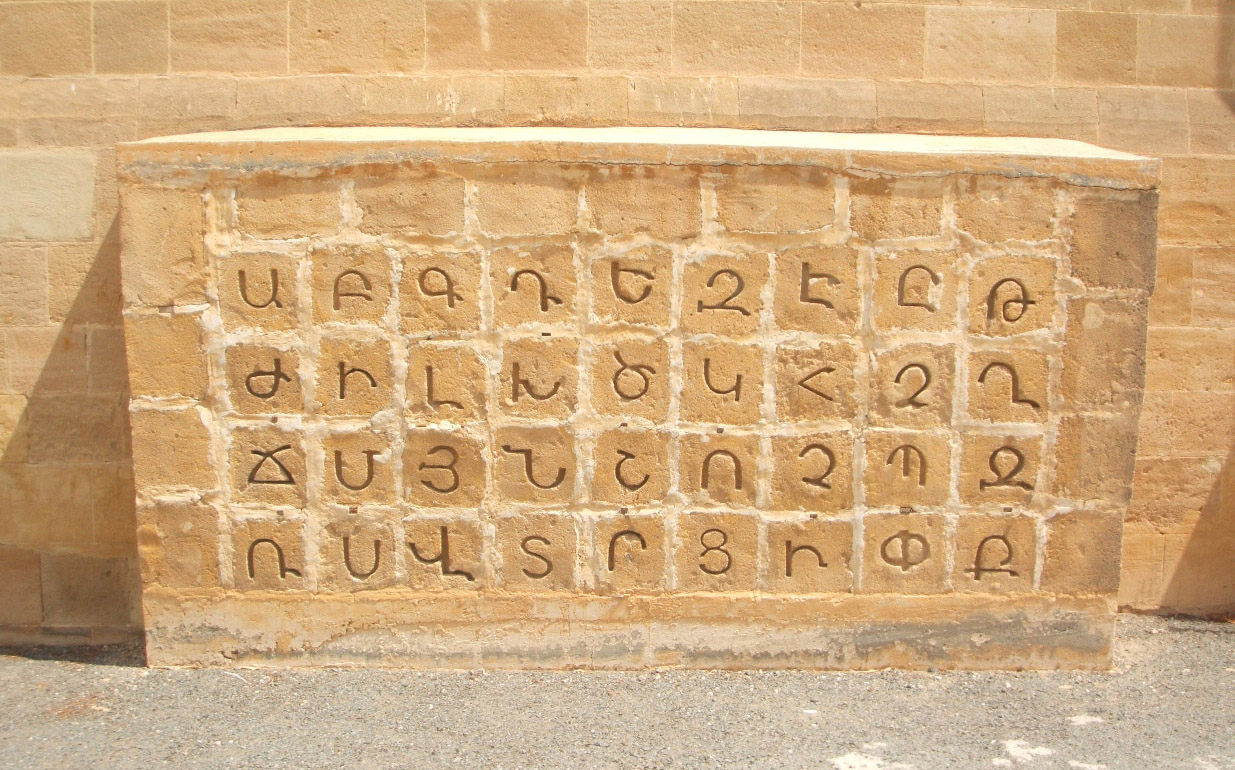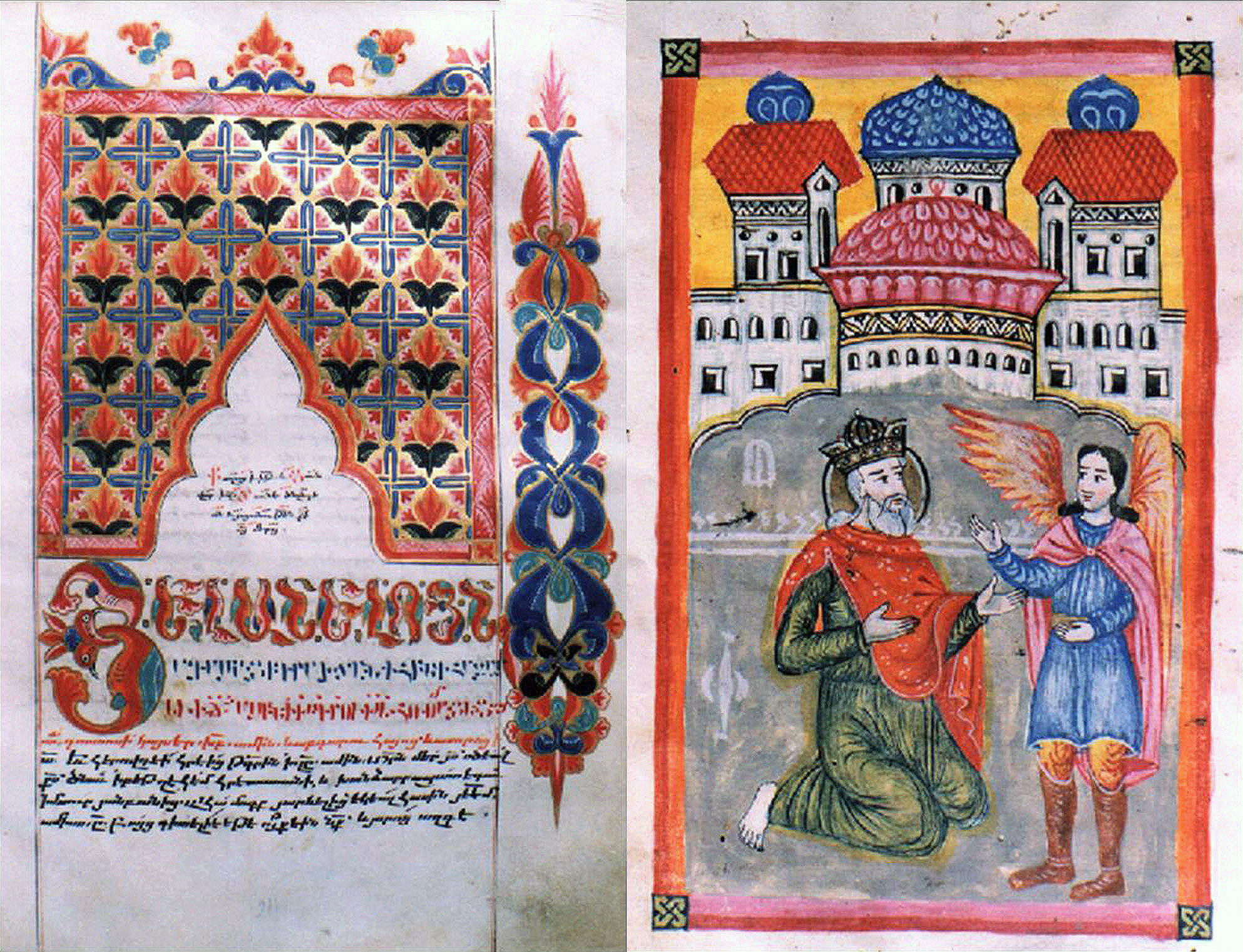Νέες Καταχωρήσεις
40 Λέξεις της Ημέρας
Αλφαβητική Αναζήτηση
Τεχνικά Θέματα
Βοηθήματα
Γλωσσικά Θέματα
Καταγράφεται
Παρατηρήσεις / Εισηγήσεις
The Armenian Language

The Armenian Language
Հայերեն լեզու
Armenian Language (Hayeren lezou)
Alexander-Michael Hadjilyra
The Armenian Alphabet as depicted oh the wall of Melconian School in Nicosia Cyprus
Work by Sebouh Abcarian.
Armenian is an independent branch of the Indo-European family of languages. Although its first traces are lost in time, with some linguists tracing it as early as in the 4th millennium BC, it is thought to be related to Phrygian and the Proto-Greek language. Originally, it was written in Greek, Persian or Syriac scripts (none of which were well-suited for representing the complex sound system of ancient Armenian), until in 405 Saint Mesrob Mashdots - a monk, theologian and linguist -, determined to translate the Bible into Armenian and having travelled around the Caucasus, invented a unique alphabet for the recording of the Armenian language. The alphabet, said to be the product of divine inspiration, is written from left to right. Originally made up of 36 letters, it was welcomed by King Vramshabouh and Catholicos Sahag I, it signalled the dawn of a “Golden Age” for the Armenian nation, and has since served as a powerful factor in developing the national Armenian spirit to this day. Because of the European influence to the Armenian Kingdom of Cilicia, two more letters were added in the 12th century.
This rich and dynamic language is the mother tongue of a nation numbering over 8 million people scattered in all four corners of the Globe, as a result of the Armenian Genocide. It is the official language of Armenia and Nagorno-Karabakh and it has numerous speakers in Russia, the United States, France, Georgia, Lebanon, the Ukraine, Iran, Argentina, Syria, Turkey, Uzbekistan, Canada, Germany, Spain, Poland, Australia, Brazil, Greece, Bulgaria and elsewhere.
In its classical form (krapar), Armenian was one of the great languages of the Near East and Asia Minor. It was phonologically affected by Georgian and the other Caucasian languages and it had received numerous loanwords from Greek, Syriac, Latin and Persian. The development of sharagan (church hymns) and the writings of various literary pillars, such as Krikor Naregatsi (951-1003), Magistros Krikor Bahlavouni (990-1059), Hovhannes Sargavak (1045-1129), Catholicos Nerses Shnorhali (1098-1173), Mkhitar Kosh (1120-1213), Archbishop Nerses Lampronatsi (1153-1198), Archimandrite Vartan Aykegtsi (†1250) and others, refined the classical Armenian language, elevating and broadening its literary style. In the 13th and 14th centuries the grammar, syntax and spelling of the language were further standardised. Classical Armenian is used to this date for church services of the Armenian Apostolic Orthodox churches around the world.
Following the fall of the Armenian Kingdom of Cilicia (1375) and the destruction of numerous monasteries, the Armenian language fell into a slumber until the 16th century: due to the dire conditions in the Ottoman Empire and Safavid Persia, the kousan (lyrical singers) and the ashough (troubadours) gradually gave poetry a secular outlook. Poets and troubadours like Ghazar Sepasdatsi, Vrtanes Srngetsi, Krikor Vanetsi, Stepanos Varaketsi, Nerses Mokatsi, Sayat Nova and others chiefly dealt with the preoccupations of the Armenians living under the yoke of Persian and Turkic rulers.
Within the general Renaissance and Enlightenment flow, Armenian printing presses were established in Venice (1511), Rome (1584), the Armenian quarter of Isfahan (1641) and Amsterdam (1666). In the 18th century more printing presses are established in Constantinople, Madras of India, Saint Petersburg, Etchmiadzin, Marseilles, Smyrna and Amsterdam. Equally noteworthy are the printing presses of the Mekhitarists in Venice, Trieste and Vienna, which contributed to preserving and spreading the Armenian language and the Armenian culture.
From the 18th century onwards, numerous institutions promoting the Armenian language were established, such as the Mekhitarist Monasteries in Venice (1717), Trieste (1773) and Vienna (1811), the Lazarian Institute in Moscow (1815), the Armenian College in Calcutta (1821), the Nersessian Academy in Tiflis (1824), the Mourad Raphaelian College in Venice (1836), the Tebrotzassere School in Constantinople (1879) and the Melkonian Educational Institute in Nicosia (1926). The first Armenian newspaper, Aztarar (Warner), was published in 1794 in India, followed by others, such as Tidag Puzantian [(Byzantine Lens), Constantinople: 1812], Arshalouis Araradian [(Dawn of Ararat), Smyrna: 1840], Govgas [(Caucasus), Tiflis: 1846], Armaveni [(Date Palm), Cairo: 1865], Yergrakount [(Globe), Manchester: 1865] etc. The first Armenian newspaper in Cyprus was published in 1900 in Nicosia and was called Kharazan (Whip).
Between the 18th and 20th centuries, the Armenian script was used to transcribe Ottoman Turkish, being easier to read and phonologically better-suited for it than the Perso-Arabic script. In fact, the first novel to be published in Turkish, Akabi Hikâyesi (1851), was written by Vartan Pasha in the Armenian script. During that time, vernacular Armenian (Ashkharapar) borrowed numerous words from Turkish and Russian. Due to the division of the Armenian homeland between the Ottoman and the Russian Empires, since the 19th century Armenian is divided into two dialects: Western Armenian (Arevm’tahayeren) and Eastern Armenian (Arevelahayeren). The former - based on the Constantinople dialect - is spoken mainly by Diasporan Armenians in Europe, the Middle East and the American continent, while the latter - based on the Ararat and Tiflis dialect - is mainly spoken in Armenia, the former Soviet Republics, as well as in Iran. Although largely mutually intelligible, there are noticeable differences in phonology, vocabulary, grammar even orthography.
Literary giants of the modern era include Khachadour Apovian (1809-1848), Mikael Nalbandian (1829-1866), Hagop Melik-Hagopian [also known as Raffi (1835-1888)], Hagop Baronian (1843-1891), Arpiar Arpiarian (1852-1908), Krikor Zohrab (1861-1915), Levon Pashalian (1863-1943), Avedis Aharonian (1866-1948), Hovhannes Toumanian (1869-1923), Levon Shant (1869-1951), Roupen Zartarian (1874-1915), Atom Yardjanian [also known as Siamanto (1878-1915)], Gosdan Zarian (1885-1969), Karekin Nzhdeh (1886-1955), Yeghishe Charents (1897-1937), Hovhannes Shiraz (1915-1984), Kevork Emin (1918-1988), Silva Gaboudigian (1919-2006), Barouyr Sevag (1924-1971), as well as Vahan Tekeyan (1878-1945) and Hagop Oshagan (1883-1948), who had been professors at the Melkonian, and Hovsep Shishmanian [also known as Dzerents (1822-1888)], who in 1875 had visited the Magaravank on Pendadhaktylos.
* * *

Today in Cyprus, Armenian is taught at the three Nareg Elementary Schools (Nicosia, Larnaca and Limassol) and Nareg Gymnasium (Nicosia). The second CyBC radio has been broadcasting Armenian programmes since 1953, nowadays daily from 17:00-18:00, the only Armenian broadcast around the region. Since 1992, an Armenian TV programme is broadcast on the day of Armenian Christmas (6 January) by CyBC, nowadays between 09:00-12:00. A bimonthly newspaper, Artsakank (Echo), is printed in Armenian, the quarterly newsletter of the Armenian Prelature of Cyprus, Mer Yegeghetsin (Our Church), and the quarterly newsletter of the Office of the Armenian Representative, Lradou (Newsletter), while every month circulates the Armenophone e-magazine Azad Khosk (Free Speech). Classical Armenian is used at the three Armenian Orthodox churches of Cyprus: at the Virgin Mary (Sourp Asdvadzadzin) in Nicosia, at Saint Stephen (Sourp Stepanos) in Larnaca, and at Saint George (Sourp Kevork) in Limassol.
On 01/12/2002 the Republic of Cyprus and the Council of Europe declared Armenian to be a minority or regional language of Cyprus within the context of the European Charter for Regional or Minority Languages. On 04/08/2005 it was specified as a non-regional language and on 27/09/2006 it was clarified that it is the Western Armenian dialect: it is estimated that Western Armenian is spoken by about 2.500 Armenian-Cypriots and over 500 Armenians from Lebanon, Syria, Greece and Egypt, while Eastern Armenian is the mother tongue of more than 500 Armenians from Armenia, Georgia, Iran and Russia.
* * *
Western Armenian has 8 vowel sounds, 24 consonantal sounds and 9 diphthongs. Nouns have six cases (nominative, accusative, genitive, dative, ablative and instrumental), two numbers (singular and plural) and no grammatical gender. Adjectives do not decline, have no gender, and they precede the nouns they qualify. Verbs have four basic tenses (Present, Imperfect, Preterite and Future), two voices (active, passive), three conjugations (-el, -il and -al), five moods (indicative, optative, conditional, jussive and imperative), and they are usually placed at the end of a sentence. Armenian is not only inflectional, but also an agglutinative language (mainly with suffixes) with a fairly free word order. It is also rich in consonantal combinations.



